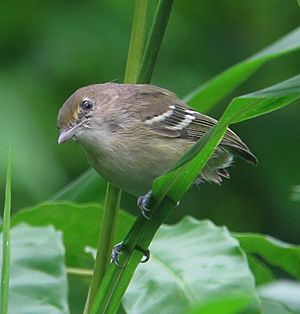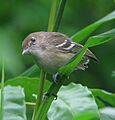San Andres vireo facts for kids
Quick facts for kids San Andres vireo |
|
|---|---|
 |
|
| Conservation status | |
| Scientific classification | |
| Genus: |
Vireo
|
| Species: |
caribaeus
|
 |
|
The San Andres vireo (also called the St. Andrew vireo) is a small bird found only on the Colombian island of San Andrés. This island is in the Caribbean Sea, close to Nicaragua. Its scientific name is Vireo caribaeus.
This special bird is a type of vireo, a family of small songbirds. It is considered a threatened species because its home is shrinking. Even though its habitat is getting smaller, you can still find many of these birds in certain parts of the island, especially in the south. They live in many different kinds of places on San Andrés.
Contents
What the San Andres Vireo Looks Like
The San Andres vireo is a small bird, about 12.5 centimeters (5 inches) long. Its back and top parts are a pretty olive-green color. Its belly and underside are whitish or a light yellow.
This bird has some unique features that help you spot it. It has two white stripes on its wings. The edges of its flight-feathers (the long feathers used for flying) are also pale. You might notice a light yellow stripe that runs from its beak to its eye. Its eyes are a grey-brown color.
Sounds and Songs
The San Andres vireo is quite vocal! It makes several different sounds. You might hear a short, chattering sound with one syllable. It also sings a song with two syllables that it repeats often. Sometimes, it sings a longer song with three syllables.
How It Compares to Other Vireos
The San Andres vireo looks a lot like two other birds: the mangrove vireo and the Jamaican vireo. However, there are small differences. The San Andres vireo has a slightly thinner and darker beak than the mangrove vireo. Compared to the Jamaican vireo, its beak is a bit longer and darker. The Jamaican vireo also has whitish eyes and a less clear stripe between its beak and eye.
Where the San Andres Vireo Lives
This bird lives only on the islands of San Andrés and Providencia. These islands are part of Colombia, even though they are closer to Nicaragua in the southwest Caribbean.
Its Home and Environment
The San Andres vireo can live in many different places on the island. You can find it in woodlands, in cocoa farms (where cocoa beans grow), in scrubby areas used for pasture, and even in mangrove swamps. It especially likes places with lots of dense plants and bushes close to the ground, which is called the understorey.
It is most common in the southern part of San Andrés island, where there are fewer buildings and cities. Scientists believe there are between 8,200 and 14,000 San Andres vireos living on the island.
Why It's a Threatened Species
The San Andres vireo lives in a very small area. This makes it sensitive to strong storms like hurricanes, which can damage its home. The biggest threat to this bird is habitat loss. As more people move to the island, more land is used for buildings and development, which means less space for the birds.
Even though its home is shrinking, the San Andres vireo is quite tough. It can handle some changes to its habitat and is still one of the most common birds on the island. However, because its home is so small and threatened, BirdLife International has listed it as a vulnerable species. This means it needs protection to survive.
San Andres Vireo Behavior and Life Cycle
The San Andres vireo finds its food by looking carefully at plants. It picks off caterpillars and other small insects and spiders (called arthropods) from the leaves and branches. This way of finding food is called gleaning.
Reproduction and Nesting
When it's time to have babies, a pair of San Andres vireos will claim a breeding territory of about 0.5 hectares (about 1.2 acres). They have been seen building nests in June.
The nest is usually built on or hangs from a branch in bushes or mangrove trees. The female bird lays two eggs. These eggs are lightly spotted.
Images for kids
See also
 In Spanish: Vireo de San Andrés para niños
In Spanish: Vireo de San Andrés para niños




